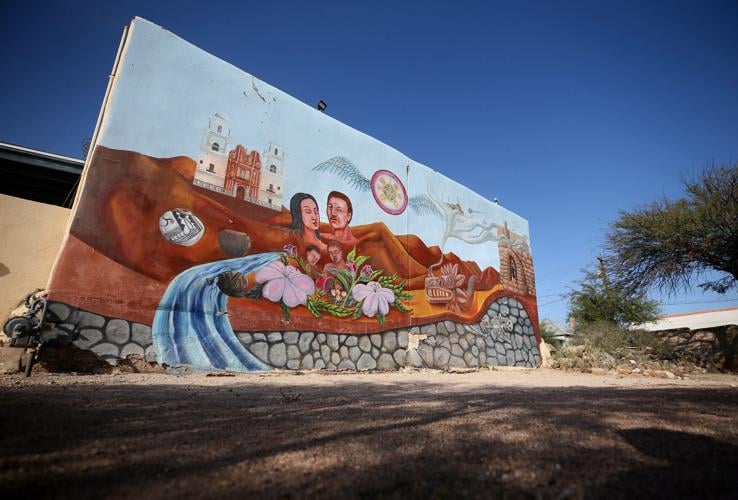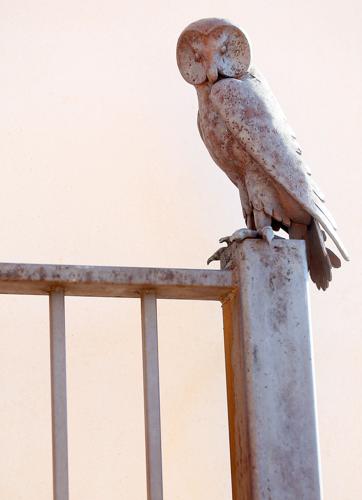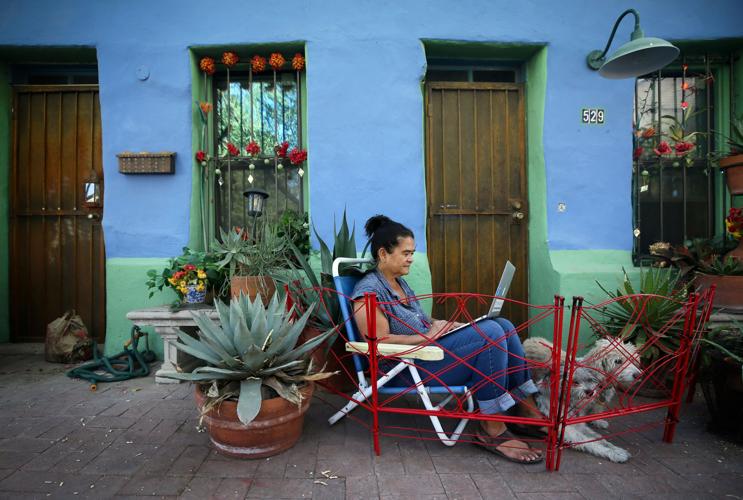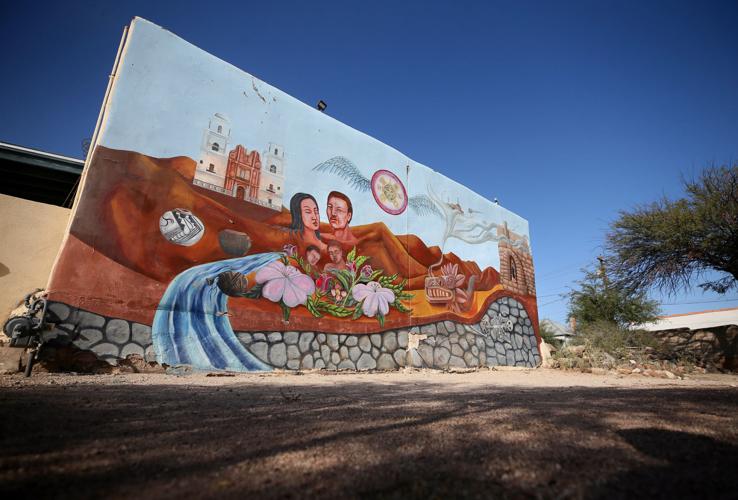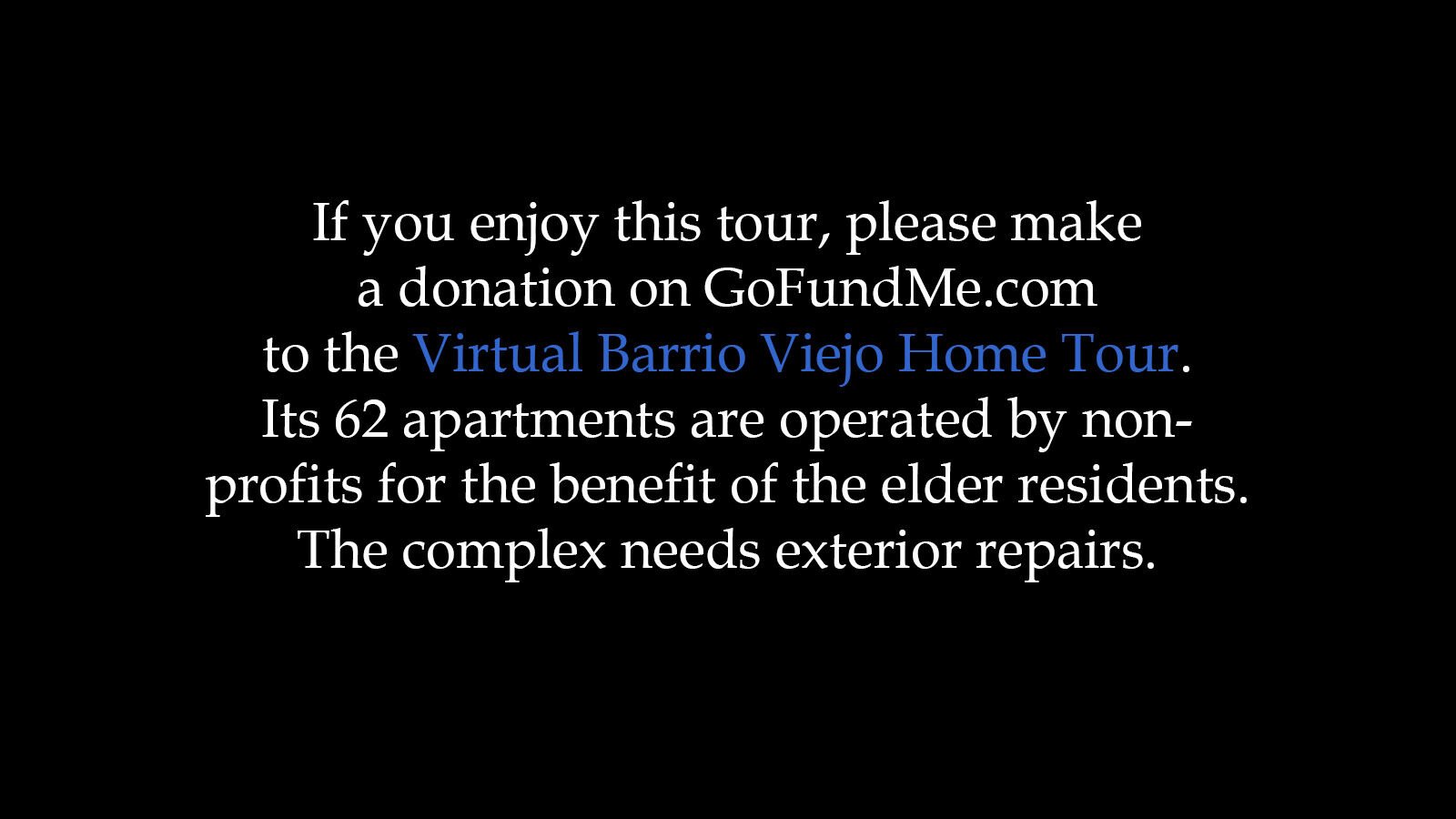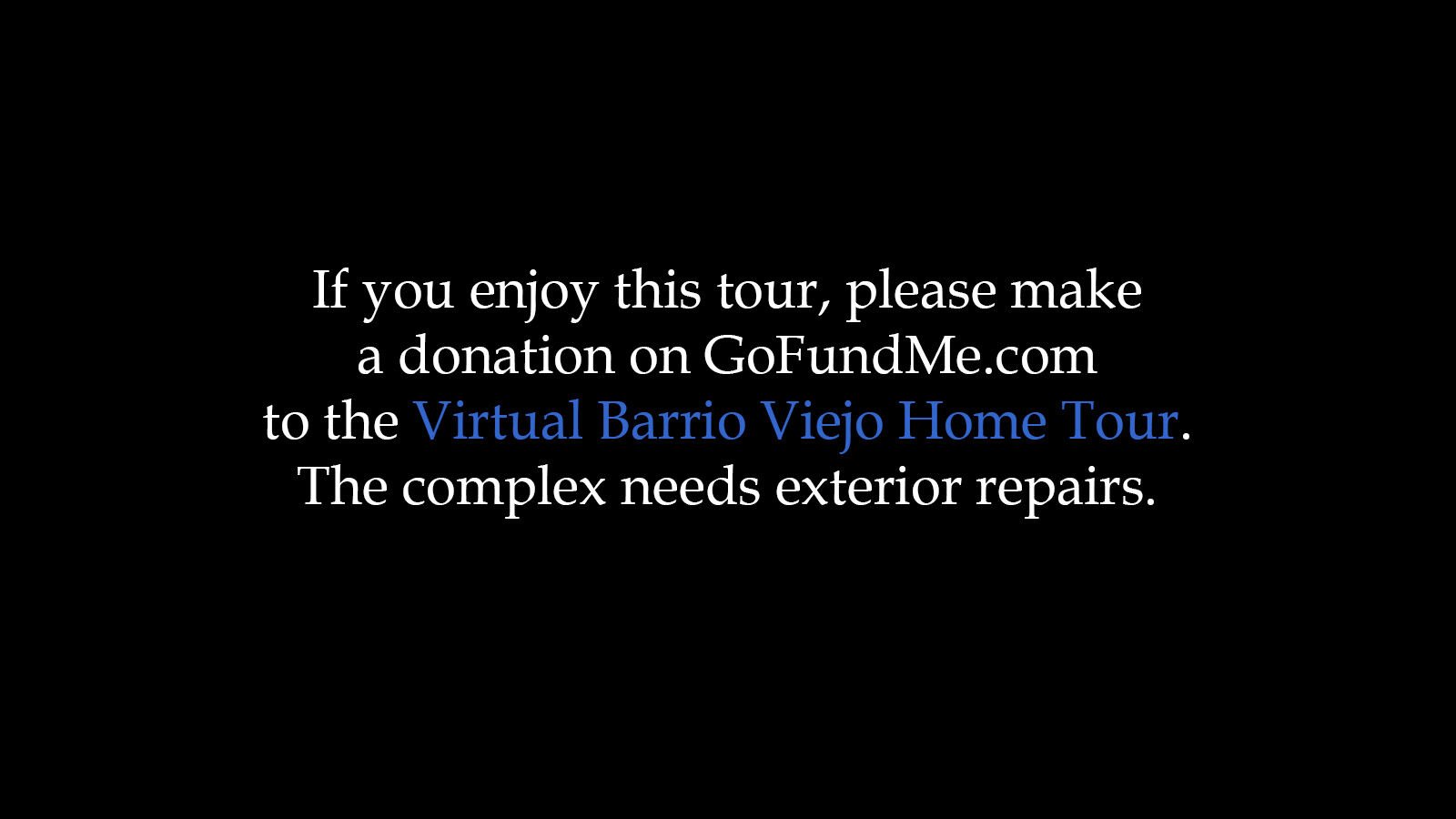When fall comes to Tucson, Tucsonans come to Barrio Viejo.
They come to take photos — families in holiday attire for Christmas cards, kissing couples for engagement announcements, and young women in bright gowns for quinceañera invitations.
Occasionally there are models on catalog shoots or a musician posing for an album cover. I once watched a child photograph two adults brandishing skillets in mock battle. What that was about, I did not inquire.
The adobes are my neighborhood’s big draw. They give photos a sense of place and make for colorful backdrops.
But the adobes have more and more competition. Art is now a reason to visit Tucson’s second-oldest neighborhood. Some of it has been around for 100-plus years, but recently there’s been an explosion of art, especially murals.
So come downtown and have a look at some of my favorite pieces of barrio creativity.
If you are driving to the barrio, a good weekend place to park is in front of Carrillo School, 440 S. Main Ave. Elsewhere, beware of permit-only parking on some streets.
Let the art tour, and a bit of barrio history, begin.
Walking tour of the historic Barrio Viejo neighborhood south of downtown Tucson. Text by Bobbie Jo Buel. Photos by Mamta Popat. Produced by Rick Wiley / Arizona Daily Star 2020
Stop No. 1: A mural on the south wall of La Pilita Cultural Center, 420 S. Main Ave., is on its second life. It was first painted in the 1980s by Martín Moreno, assisted by youth, including some from the neighborhood. The mural was taken down about 2010 during restoration of the building and then re-created by Moreno in 2011. He kept the main features and added new detail.
Stop No. 2: Directly east, there’s a huge mural featuring a young woman, backed by what appears to be Saint Augustine Cathedral in Tucson sunset hues. The piece, by Isaac Caruso, is on the north wall of La Suprema Works & Events, a recently renovated co-working and events space. The building, at 319 W. Simpson St., was first a Chinese market and then for many years a tortilla factory. I remember kids sitting on the curb eating free tortillas the business sometimes gave away after school let out across the street. After the factory closed in about the late ’80s, the building fell into great disrepair. Katina Koller restored the building, and she and her business partner, Gina Catalano, opened La Suprema Works last winter.

Mamta Popat / La Estrella de Tucson
Kellie Kongnso, propietaria de Lash Factor Studio, encargó al muralista J. Keegan Rider que creara este pequeño mural en la esquina sureste de Simpson Street y Meyer Ave.
Stop No. 3: Walk a block east on Simpson to Meyer Avenue. The barrio’s newest mural, finished this month, is a splash of color in the form of a cacti and flower garden on the short wall at the southeast corner. Kellie Kongnso, owner of Lash Factor Studio, commissioned muralist J. Keegan Rider to create something bright and happy. His desert garden attracted neighborhood admirers who regularly checked on his painting’s progress this summer.

Mamta Popat / La Estrella de Tucson
Stop Nos. 4 & 5: Turn north and head to 369 S. Meyer, which has been guarded since 1973 by a large metal owl and secured by a turtle-shaped latch. There’s more delight next door at 363, where delicate animals, including a bighorn sheep, longhorn and tiny mouse are part of the rejas (window bars). The animal affair was the brainchild of the property owner, the late Kelley Rollings, and master blacksmith Tom Bredlow.

Stop No 5: A rabbit is part of the window bars at 363 S. Meyer Ave.
The building at 363, by the way, is one of the oldest in Tucson. UA tree-ring examination of the the ceiling beams shows they were harvested in the Santa Rita Mountains in the 1850s. The building went up around 1860.
Stop No. 6: Keep going north to the end of Meyer where the Tucson Convention Center hotel is nearing completion across the street. Turn east, stopping in front of the yellow office at 124 W. Cushing St. Look up. The barrio has many whimsical canales, which are tin pipes for carrying rainwater off flat roofs and away from mud-adobe walls. These, which seem to depict woodpeckers, were another ’70s-era Rollings inspiration.

Stop No. 7: A metal art installation also serves as fencing at WomanKraft Art Centers, 388 S. Stone Ave.
Stop No. 7: Continue east on Simpson to Stone Avenue, then turn right to WomanKraft Art Centers (aka the castle) at 388 S. Stone. The art installation, which also serves as a fence, is titled “The Intimation of Victorian Wings,” and mimics shapes of the house it protects. Metalsmith Josh Smith created it about seven years ago. The entry pillars were tiled by WomanKraft volunteers nearly 30 years ago.

Stop No. 8: “Peggy Sue,” a mural by Danny Martin was painted at a private residence, 25 W. Simpson St., but can be seen from public view.
Stop No. 8: At the south end of WomanKraft look west, down the driveway. That’s “Peggy Sue,” the creation of Danny Martin, a UA alum and prolific muralist. Inspired by Day of the Dead imagery, the mural is among many distinctive skeletal portraits created by Martin. Peggy Sue is actually on a residence around the corner, but this is the best public vantage point. Go to that house next — at 25 W. Simpson — to see a second terrific mural. Tucson native Joe Pagac created “Tribute Mural” to honor the original homeowners, Andres and Guadalupe Herrera, who built the home in 1906, as well as Frank Bone, who resided there for more than 40 years.

Stop No. 8: “Tribute Mural” by local artist Joe Pagac painted at a private residence at 25 W. Simpson St. The mural was created to honor the original homeowners, Andres and Guadalupe Herrera, who built the home in 1906.
Instrumental to Tucson’s development was the Southern Pacific Railroad, which first rolled into Tucson in 1880. In a nod to this history, Pagac incorporates a soaring train along with a row of more typical adobes homes. These two barrio-centric “characters” twist like strands of DNA between Pagac’s brilliant Sonoran sunset and desert landscape. Feel free to take a few steps down the driveway for a better view. If the property owners are at hand, they will open the gate to afford you a closer look.

Stop No. 9: On the northeast corner of Simpson St. and Convent Ave. an old grocery store has ghost art of the items it used to sell.
Stop No. 9: Continue west on Simpson to Convent Avenue. Look closely at the south side of the building at the northeast corner. In faint blue lettering it says “Las 4 Esquinas” — the Four Corners. This ghost art is a glimpse of the barrio long ago. Grocers or general shops were at three of the four corners as far back as 1888. I don’t know when this building was first called Las 4 Esquinas, but it carried that name by 1917 at the latest. It was operated by Don Wah and his wife, Fok Yut Ngan, both Chinese immigrants. Sitting on the wood curb, their daughter Esther used to pan for sand rubies in the rush of runoff down Simpson after summer storms.
More faded paint advertises some of what the Dons sold — yerbas Mexicanas, remedios, abarrotes, postales and novenas. The sign (translated as Mexican herbs, remedies, groceries, postal supplies and prayer devotionals) is a reminder that the barrio back then was primarily a neighborhood whose residents had their roots in Mexico. Indeed, Tucson was part of Sonora until the Gadsden Purchase in 1854.
Las 4 Esquinas seems to have closed in the 1950s and has been part of a complex of residential rentals ever since. Renovation recently started on two of the buildings along Simpson.

Stop No. 10: Most of the buildings on Convent Street were demolished in the late 1960s to make way for the Tucson Convention Center.
Stop No. 10: Walk south on Convent along a stretch that in 1884 was home to a rancher, miner, laborers, grocer, trader and machinist. By the 1970s, the neighborhood had fallen on hard times, no thanks to governmental neglect (such as irregular trash pickup) and the refusal of insurance companies to provide coverage homeowners needed to obtain mortgages. When my husband first moved to the barrio in 1977, he couldn’t get insurance from a U.S. company. Lloyd’s of London finally sold him a policy.
Construction of the Tucson Convention Center wiped out the commercial heart of the barrio by 1971, and more would have been demolished for a freeway if not for neighbors and preservationists banding together to stop it.
There are “new” houses on this block of Convent as well, built in the 1980s.

Stop No. 11: A home at Convent Avenue and Kennedy Street is adorned with names and love declarations carved into the brick.
Stop No. 11: At the next intersection, Convent Avenue and Kennedy Street, stop to look at the walls of the large brick house at the southwest corner. I am of the opinion that most graffiti is vandalism, but the sheer number of names scratched into the soft brick over many years throws this into the category of art.
Stop No. 12: Keep strolling west on Kennedy to Meyer Avenue, then turn south. The newly restored house at 505 S. Meyer was the boyhood home of the barrio’s most famous resident, Eduardo “Lalo” Guerrero, the father of Chicano music. Though he eventually moved to Los Angeles, his heart remained in Tucson, and he later wrote a song called “Barrio Viejo.” The Lalo Guerrero apartments, a nonprofit complex for seniors at Convent and 18th Street, were named in his honor when they opened in 2003. They are on the site of the original Drachman School, which he attended. He died in 2005.

Stop No. 13: Another ghost sign was revealed during a home renovation at 508 S. Meyer Ave. in the early 2000s.
Stop No. 13: There’s another wonderful ghost sign at 508 S. Meyer, uncovered during a renovation in the early 2000s. It advertises root beer, cimarrona (snow cone) and soda helada (iced soda) for five cents. Neighbors say the shop operated in the 1950s. The same building was home to La Costa del Pacifico bakery in the 1920s.

Mamta Popat / Arizona Daily Star
Stop No. 14: A mural by Johanna Martinez featuring Lalo Guerrero can be seen at 600 S. Meyer Ave.
Stop No. 14: At 600 S. Meyer, Lalo Guerrero pops up again on this 2009 mural by Johanna Martinez. The building, now an office, opened in 1912 as Lee Ho’s general store. It was one of dozens of Chinese-owned markets along Meyer between Broadway and 18th Street. He eventually turned over operation to his son, Jerry Lee Ho. Father and son are part of this mural, as is Jose C. Moreno, the operator of Pacifico bakery. The building was last a grocery in 2002.
Stop No. 15: At the intersection of Meyer and 17th Street, take a brief detour east. Look high up at the west wall as you approach the yellow building at 219 W. 17th St. Notice the big metal ants marching four by four.

Mamta Popat / Arizona Daily Star
Stop No. 16: A monsoon inspired mural by Jessica Gonzales is painted on the wall of a private residence at 592 S. Ninth Ave.
Stop No. 16: Turn back west on 17th and head to Ninth Avenue. It’s a bit confusing because the avenue jogs, but keep going west until you can hang a right. There’s a terrific monsoon-inspired mural by Jessica Gonzales on the south wall of a year-old house at 592 S. Ninth Ave. Ninth is another street with a large mix of old and new homes.
Return to 17th Street and walk west a half block to Main, the street where this tour began.
If you visit on a weekend in October or November, during photographers’ favorite “golden light” hours of early morning or late afternoon, there’s a good chance you will spot little kids in Christmas clothes, a bride or a teen in a huge party dress. BYO camera.
Walking tour of the historic Barrio Viejo neighborhood south of downtown Tucson. Text by Bobbie Jo Buel. Photos by Mamta Popat. Produced by Rick Wiley / Arizona Daily Star 2020
Photos: Take a virtual tour of these Barrio Viejo homes in Tucson
Barrio Viejo virtual home tour
Updated
Welcome to the Barrio Viejo virtual home tour, benefitting the neighborhood’s Lalo Guerrero elder apartments. More about that later, but let’s get started with the tour, which features homes built from the 1880s right up until last year.
Barrio Viejo virtual home tour
Updated
This recently restored 1911 adobe on South Meyer Avenue was the childhood home of Eduardo “Lalo” Guerrero, the father of Chicano music. He lived most of his adult life in Los Angeles, but a barrio complex of apartments for seniors was named in his honor in 2003. This Barrio Viejo virtual home tour benefits the neighborhood’s Lalo Guerrero elder apartments. Find the fundraiser here.
Barrio Viejo virtual home tour
Updated
Owners Amanda and Luke Kippert replaced the home’s roof and electrical system, installed air conditioning and made other major improvements in an Art Deco style. Danny Quihuis of Quihuis Architecture Co. helped with the project.
Barrio Viejo virtual home tour
Updated
Guerrero, in the two photos on the left, was born Christmas Eve 1916. He learned to play the guitar when he was nine and by 17 wrote and performed what would become one of his most famous songs, “Canción Mexicana.” The 1936 musician comedy “The Gay Desperado” was filmed on South Meyer Avenue in a part of the barrio later torn down for construction of the Convention Center.
Barrio Viejo virtual home tour
Updated
Pops of gold throughout the house give it glamour.
Barrio Viejo virtual home tour
Updated
Notice the fancy gold feet on the old bathtub?
Barrio Viejo virtual home tour
Updated
The pièce de résistance of the Lalo house is the patio mural by Sal Sawaki of Wagon Burner Arts.
Barrio Viejo virtual home tour
Updated
“Hot Pink Neighbor” by Ron Kenyon. He is a member of the Tucson Barrio Painters, a group of “plein air” painters who have long appreciated the architecture of the city’s barrios. Three years ago, as they noticed accelerating changes, they decided to make a more organized effort to capture the barrios on canvas.
Barrio Viejo virtual home tour
Updated
This house, built in the 1880s, had become a near-ruin by the time it was restored over three years in the early 1980s. Walls had to be rebuilt, and the original dirt, clay and manure roof removed. The cabinets were salvaged from the long-gone Damsky Cigars shop on East Congress Street.
Barrio Viejo virtual home tour
Updated
Many old barrio homes are built on the lot lines, leaving no front or side yards. But shady back patios are common.
Barrio Viejo virtual home tour
Updated
Notice the thickness of the adobes that case the windows. The ceilings are saguaro ribs.
Barrio Viejo virtual home tour
Updated
“Four doors” by Denyse Fenelon. “Barrio communities should be nurtured and appreciated for the architecture, lives and stories that have happened here. It’s hard to save what you can’t see so we’re attempting to preserve, in our way, the story of Tucson,” writes Fenelon, organizer of the Tucson Barrio Painters.
Barrio Viejo virtual home tour
Updated
Several dozen homes have been built in the barrio in the past 15 years, either on lots where houses had been demolished years before or on land that had always been vacant. This house was built in 2017 by a couple that already had family connections to the barrio.
Barrio Viejo virtual home tour
Updated
The living room and kitchen are part of an open-concept area designed for family gatherings.
Barrio Viejo virtual home tour
Updated
The kitchen takes advantage of the home’s high ceilings. That’s another nod to the design of many of the barrio’s oldest buildings.
Barrio Viejo virtual home tour
Updated
Luis H. Ibarra of Saavy Inc. was the general contractor.
Barrio Viejo virtual home tour
Updated
A Tucson-made patio bench gives the home a sense of place. “Be Kind” is the motto of the beloved Ben’s Bells project.
Barrio Viejo virtual home tour
Updated
From the street, the home hews to a traditional Sonoran style. It is built on the lot lines and has a flat roof. But the patio shows that is a modern structure.
Watch now: Peek inside this Barrio Viejo home near downtown Tucson
UpdatedFind more Barrio Viejo homes at tucson.com/barrioviejo (Video by Gloria Knott, Arizona Daily Star)
Barrio Viejo virtual home tour
Updated
Barbara Mulleneaux recently painted this long-vacant building at West Kennedy Street and South Meyer Avenue.
Barrio Viejo virtual home tour
Updated
This pre-1888 front room opens to the kitchen and dining area, then a laundry with an adjacent bathroom, and finally the rear bedroom and a doorway to the central courtyard. Years ago this type of design was referred to as a shotgun because the rooms line up like the long barrel of a shotgun. Brick floors have replaced the original wood floors, but the variegated light & dark gypsum interior plaster is a longtime Old Pueblo tradition.
Barrio Viejo virtual home tour
Updated
This chandelier highlights the rough-sawn fir joists and old-growth planks a full 2 inches thick. Ceilings nearly 12 feet high kept hot air high in the summers when many Tucsonans slept outdoors on canvas cots or improvised hammocks.
Barrio Viejo virtual home tour
Updated
Till the 1990s this adobe room had two feet of dirt above its fir joists and packing crate planks. That was its original roof. One of the planks still visible today is addressed to "Geo. Martin", Arizona's second druggist.
Barrio Viejo virtual home tour
Updated
A clean, sleek bedroom for this old house.
Barrio Viejo virtual home tour
Updated
Large skylights with white domes provide soft, diffused light for this kitchen, which has no windows. The room originally opened to a long porch 7 feet in depth, but early 20th century additions closed off even that bit of light, so skylights were an adaptation.
Barrio Viejo virtual home tour
Updated
This iron fence recycles old gas and water pipe salvaged from a large complex of former apartments restored from 1998-2000. Some of the adobe walls had collapsed, and the property was condemned. Designer-builder David Carter's material costs for the fence totaled just under $19 for the caps on the posts. Welder Jim Fredd was the fabricator.
Barrio Viejo virtual home tour
Updated
José Trujillo built this market in the western part of the barrio in the 1920s. It eventually became apartments -- including home to motorcycle riding tenants who changed oil in the living room -- an addiction-counseling center, a bed-and-breakfast and a home. This painting is by Dina Jasensky.
Barrio Viejo virtual home tour
Updated
Joyce Nelson painted “Las 4 Esquinas,” one of the most iconic buildings in the barrio. Grocers or general shops were at three of the four corners at West Simpson Street and South Convent Avenue as far back as 1888. It isn’t clear when the building was first called Las 4 Esquinas, but it carried that name by 1917 at the latest. It was operated by Don Wah and his wife, Fok Yut Ngan, both Chinese immigrants.
Barrio Viejo virtual home tour
Updated
This 900-square-foot adobe was built before 1920. This is how it looked until about two years ago.
Barrio Viejo virtual home tour
Updated
The new owners who restored the house say they were inspired by homes in San Miguel de Allende, Mexico.
Barrio Viejo virtual home tour
Updated
Many interior items, such as lights and this sofa, were second-hand finds.
Barrio Viejo virtual home tour
Updated
A kitchen right out of Mexico.
Barrio Viejo virtual home tour
Updated
The homeowners’ next project is to build a new sister structure on the same property. Follow their work on Instagram at weboughtanadobe.
Barrio Viejo virtual home tour
Updated
Russell Recchion painted this building at Convent and Simpson.
Barrio Viejo virtual home tour
Updated
The vigas (wood beams) in this house were salvaged from trees burned in the 2002 Mount Lemmon fire. The home was built 10 years ago. The painting shows Miguel Hidalgo y Costilla, the father of Mexican independence. It was salvaged nearly 40 years ago from the Los Reales landfill.
Barrio Viejo virtual home tour
Updated
Niches are common elements in older Mexican homes.
Barrio Viejo virtual home tour
Updated
The homeowners were walking in Guadalajara, Mexico, when they spotted workers installing a new roll-up garage door. The old iron gates were piled next to the street as trash. Shipped to Nogales by rail, they are now part of the back patio.
Barrio Viejo virtual home tour
Updated
This brick barrel vault was erected in three weeks without any formwork or other support. Every brick was set in place over thin air. Not till each row received its last brick was that row an arch -- a substantial structure.
Barrio Viejo virtual home tour
Updated
Norm Sherwood painted the long-unused Teatro Carmen at 348 S. Meyer. It was built in 1915 by Carmen Soto Vásquez and was an elegant theater seating up to 1,400. Performers came from as far as Mexico City to appear in plays and operas. By about 1920 it became a movie theater and also hosted dances and boxing matches. It later became a garage and then the Black Elks Lodge.
Barrio Viejo virtual home tour
Updated
This home was designed by Sonya Sotinsky of FORS architecture + interiors as envisioned by its owners and built in 2015 on a vacant lot by Jamie Olding of Building Excellence, LLC.
Barrio Viejo virtual home tour
Updated
Mike Runde of The Runde Company built the Rumford fireplace, which is tall and shallow to reflect more heat. Homeowner Joe Patterson started the painting on the right, of John Street in Hartford, Conn., in about 1987. It was not quite finished, but his spouse, Kathleen McNaboe, framed it anyway. After they moved to the barrio, Joe removed the frame and completed his piece.
Barrio Viejo virtual home tour
Updated
Mike Tanzillo of Tanzillo and Son built cabinets and millwork work the house, which has a modern interior with steel counters and polished concrete floors.
Barrio Viejo virtual home tour
Updated
The kitchen is part of the light-filled great room.
Barrio Viejo virtual home tour
Updated
The office looks into a courtyard with a variety of fruiting trees.
Barrio Viejo virtual home tour
Updated
High ceilings help make the bedroom spacious
Barrio Viejo virtual home tour
Updated
This bathroom is tucked behind the bedroom.
Barrio Viejo virtual home tour
Updated
David Rojo of Rojo Construction LLC built the home’s metal planter boxes. The outdoor tile art is by Carly Quinn of Carly Quinn Designs.
Barrio Viejo virtual home tour
Updated
The home’s exterior celebrates the rich history of the barrio with hard troweled hand plaster and wood gates and shutters.
Barrio Viejo virtual home tour
Updated
“Two Minutes to 5 Points,” by Terri Gay refers to the five-way intersection of 18th Street and Stone and Sixth avenues.
Barrio Viejo virtual home tour
Updated
Back in 2014, the Star’s Tom Beal chose saguaro ribs as one of 100 objects that define Tucson. Here’s how he explained it: “Saguaro ribs were functional in early Tucson, where wood and metal were hard to come by before the railroad arrived in 1880. The ribs of the saguaro cactus, with an insulating layer of grass and native dirt piled atop them, served to fill in the spaces between roof beams hauled from nearby mountains. In Spanish, the beams are called “vigas” and the lateral pieces “latillas.” The ceilings of sleeping rooms were often covered with a sheet of muslin to keep the dirt from falling into your mouth as you snored away at night. You’ve no doubt seen the durable ribs on dead saguaros after the flesh falls away.” Ribs are still found in many of the barrio’s oldest homes.
Barrio Viejo virtual home tour
Updated
Integral color was mixed with gypsum and perlite to create this variegated plaster.
Barrio Viejo virtual home tour
Updated
Barrio painter Peter Farrow’s take on Las 4 Esquinas.
Barrio Viejo virtual home tour
Updated
This is one of four homes developed by Warren Michaels on the site of what had been a bakery. Rob Paulus was the architect and Dave Taggett the builder. The walls are Mikey Block, a lightweight but strong material with high thermal value.
Barrio Viejo virtual home tour
Updated
The “Tucson” letters are from the old Greyhound bus station. The homeowners, Laura Walton and Dave Hamra, found them at Gather, A Vintage Market.
Barrio Viejo virtual home tour
Updated
La Fortuna, the original bakery on this South Meyer Avenue site, was started by the Figueroa family in the 1920s.
Barrio Viejo virtual home tour
Updated
Artist Poe Dismuke of SamPoe Gallery in Bisbee created the high-flying cicada.
Barrio Viejo virtual home tour
Updated
The patio is designed after traditional barrio gardens with pomegranate and figs trees, and a ramada of mesquite and ocotillo supporting gravevines. It also includes a modern water-harvesting system.
Barrio Viejo virtual home tour
Updated
Johanna Martinez honors the property’s history with the La Fortuna mural.
Barrio Viejo virtual home tour
Updated
“Simply Green” by Barbara Mulleneaux. The home is on South Meyer Avenue.
Barrio Viejo virtual home tour
Updated
This is one of nine condos in a complex built in the 1880s as a livery and bunkhouse for the Palace Hotel, which was seven blocks north in the heart of downtown. In those days, when visitors came to town on horses, it wouldn’t do to keep animals right next to a nice hotel.
Barrio Viejo virtual home tour
Updated
The complex’s fireplaces weren’t built to today’s code standards, so they are decorative rather than functional.
Barrio Viejo virtual home tour
Updated
Designer Linda Robinson, winner of the Master of the Southwest award from Phoenix Home & Garden, advised the homeowner on the interiors.
Barrio Viejo virtual home tour
Updated
Many of the furnishings and lights are from Adobe House Antiques and Arte de la Vida. The home’s custom window hardware is by Perry Luxe.
Barrio Viejo virtual home tour
Updated
Picture-rail moulding along the walls means there’s no need to drill into the plastered adobe to hang art.
Barrio Viejo virtual home tour
Updated
Terri Gay painted this vacant house at West Cushing Street and El Paso. Most members of the Tucson Barrio Painters have social media accounts or web sites. Search individual names for more information about their art.
Barrio Viejo virtual home tour
Updated
The Lalo Guerrero apartments at West 18th Street and South Convent Avenue are on the site of the original Samuel Drachman Elementary School. It was built in 1901 as a four-room school but expanded over the years. Fire destroyed 80 percent of it in 1948. It was rebuilt but had fallen into disrepair by 1997 when a new school was constructed three blocks south.
Barrio Viejo virtual home tour
Updated
All but the central facade of the school was demolished just before its 100th anniversary. Federal and state grants and loans paid for construction of the 62 apartments now on the site. Pio Decimo and Barrio Viejo Elderly Housing Inc, non-profit corporations, operate the apartments on behalf of their residents.
Barrio Viejo virtual home tour
Updated
Eduardo “Lalo” Guerrero attended Drachman in the 1920s and also the dedication of the apartments in 2003. World famous as a singer, songwriter and guitarist, he died in 2005.


